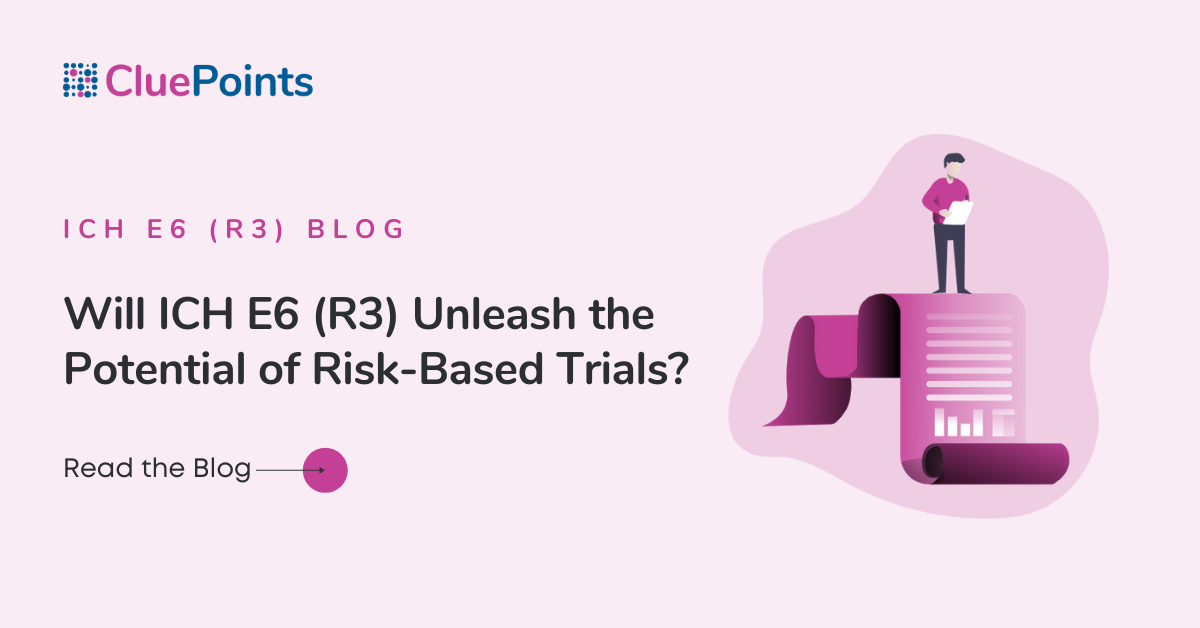Researchers have been slow to fully adopt innovations designed to overcome the challenges to modern day clinical research, in no small part due to a lack of clarity around their Good Clinical Practice (GCP) use.
But an imminent update to the International Harmonization Council’s (ICH) guidelines could be about to change all that and in doing so unleash the true potential of Risk-Based Quality Management (RBQM).
We look at the case for RBQM in clinical trials, why ICH E6 (R2) failed to accelerate its adoption, and how E6 (R3) could set the scene for the future of drug development.
The Story So Far
For decades, clinical research has been taking longer and getting more expensive. Latest estimates have put the average cost of bringing a new drug to market at somewhere between $1.3billion and $2.8billion.
As medical science evolves, drugs have become ever more advanced, and patient populations ever more targeted, making research ever more complex.
At the same time, new and more efficient ways of working have been emerging. Adaptive trial designs and the centralized monitoring of data, for example, have sought to streamline the process of clinical development and offer the opportunity to revolutionize research.
This new paradigm has enabled researchers to focus on what matters most to the study. Rather than the resource-intensive process of frequent site monitoring visits to verify every parameter of a trial, RBQM enables a more intelligent, targeted approach that focuses on key study risks and on the most critical safety and efficacy data leading to more efficient studies that protect participants and data integrity.
The proof of this approach is in the pudding. At the start of 2020, the scientific community was faced with an unimaginable task: to develop, test, and deploy effective COVID-19 vaccines at lightning speed without compromising on safety.
Despite the multitude of challenges, Pfizer and BioNTech’s mRNA product received regulatory approval just 266 days after the World Health Organization’s pandemic declaration.
This was achieved with the help of an agile, risk-based approach to the pivotal clinical trial. At CluePoints, we worked with the team to set evolving, study-specific key risk indicators (KRI) and quality tolerance limits (QTL) which were analyzed daily and fed back to study teams using powerful data visualizations.
Despite such potential, RBQM is still the exception, rather than the rule, in drug development. The reason, many in the industry argue, is that GCP guidelines have not kept pace with advances in technology and processes.
The Problem with ICH E6 (R2)
ICH was established in 1996 to set international standards for ethical and scientific quality in the design, conduct, recording, and reporting of clinical trials. Fast forward almost 25 years, and the drug development landscape is almost unrecognizable.
In 2016, the ICH updated its guidelines ICH E6 (R2) with the aim of supporting innovation and encouraging the wide-scale use of RBQM. But it didn’t fully spell out how sponsors and CROs should embrace this new way of working.
The resulting lack of clarity meant researchers were unsure about how to proceed. It means many have ignored the possible advantages of RBQM. Others have over-complicated processes by collecting and monitoring all forms of data rather than just those that matter, and in doing so defeated the very object of RBM.
ICH E6 (R2) has also acted as a roadblock to adaptive trial designs, by asking teams to define all key parameters at the start, without allowing for change throughout study execution. While this is the modus operandi of traditional studies, adaptive trials are designed to facilitate risk-assessed modifications as answers to research questions become clear.
Another area where (R2) has stifled advances is in technology uptake. Patient-centered practices that reduce participant burden are well known to play a role in increasing recruitment and retention rates. Yet the guidelines are unclear on whether innovations designed to make sign up more convenient and engaging, such as eConsent, are acceptable.
Ultimately, researchers still feel obligated to focus on less important aspects of clinical trial data to ensure GCP compliance. This sacrifices the efficiency benefits of RBQM and adds unnecessary, though well-intentioned, layers of complexity to study design, conduct, and reporting.
What Can We Expect From ICH E6 (R3)?
After extensive consultation with the clinical research community, work on ICH E6 (R3) is active and publication of the first part, Annex 1, is expected later this year.
With technology evolving so quickly, the challenge has been developing guidelines that are flexible enough to move with the times, while still protecting participant safety and data quality and integrity.
At a two-day online meeting, held in May, the ICH set out the direction of travel, and outlined the vision of the updated guidelines.
The purpose of the GCP renovation, said the team, was to emphasize the role of achieving quality by design (QbD), and to ensure that innovations in technology and design are facilitated and encouraged.
(R3), they explained, will “set the foundations for responsible and efficient clinical trial conduct” by providing “principles that remain relevant as technology, methods, and design evolve”.
The guidance is expected to contain a range of tech-agnostic principles:
- Clinical trials should be conducted in accordance with the ethical principles that have their origin in the Declaration of Helsinki and that are consistent with GCP and applicable regulatory requirements
- Clinical trials should be designed and conducted in ways that ensure the rights, safety, and well-being of participants
- Informed consent is an integral feature of the ethical conduct of a trial. Clinical trial participation should be voluntary and based on a consent process that ensures participants are well informed
- Clinical trials should be subject to objective review by an institutional review board or independent ethics committee
- Clinical trials should be scientifically sound for their intended purpose, and based on robust and current scientific knowledge and approaches
- Clinical trials should be designed and conducted by qualified individuals
- Quality should be built into the scientific and operational design and conduct of clinical trials
- Clinical trial processes, measures, and approaches should be proportionate to the risks to participants and to the reliability of trial results
- Clinical trials should be described in a clear, concise, and operationally feasible protocol
- Clinical trials should generate reliable results
- Roles, tasks, and responsibilities in clinical trials should be clear and documented appropriately
- Investigational products used in a clinical trial should be manufactured in accordance with applicable Good Manufacturing Practice standards and be stored, shipped, and handled in accordance with the product specifications and the trial protocol.
Of note to researchers hoping for more clarity around the use of RBQM are the focuses on QbD (principle seven) and risk-based approaches (principle eight), both of which clear the way for more widespread adoption of modern research practices.
In addition, they appear to be sufficiently flexible to allow the industry to embrace advances in innovations as they arise.
Under principle seven, for example, the draft guideline states: “Factors critical to the quality of the trial should be identified. These factors are attributes of a trial which are fundamental to the protection of participants, the reliability and interpretability of the trial results, and the decisions made based on those trial results.”
In terms of RBM, R3 offers something of a recipe for effective deployment, touching on how trial processes should be proportionate to the risks inherent in the trial and the importance of the information being collected. It also advises the quality factors to be prioritized at the time of the trial design to identify those that are critical to the study.
In all, then, R3 has the potential to offer a much-needed framework for RBQM.
The Evolving Picture
Medical science is evolving at an incredible rate, and the tech sector is playing its supporting role admirably by designing and launching innovations that allow researchers to increase their likelihood of success and streamline timelines, while protecting safety.
Lack of clarity about how such approaches fit into GCP has, to date, hampered uptake, but the publication of R3 looks set to unshackle the potential of RBQM and set the scene for the drug development landscape for years to come.




